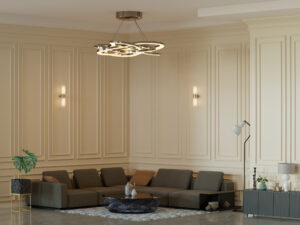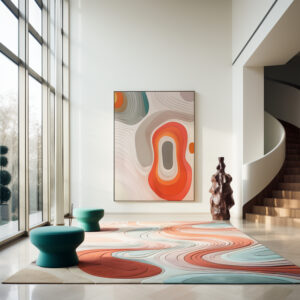In the bustling cities of India, where life moves at a dizzying pace, there’s a growing desire for calm, uncluttered spaces. Enter the world of minimalist home decor ideas – a design philosophy that’s capturing the hearts of young Indian professionals and families alike.
If you’re in your late twenties or early thirties and yearning for a home that exudes both luxury and practicality without breaking the bank, you’re in for a treat. Let’s explore how the minimalist interior design style can transform your living space into a haven of tranquility and sophistication.
What is Minimalism?
Minimalism is more than just an interior design style; it’s a way of life. Rooted in the principle of “less is more,” it emphasizes simplicity, functionality, and the elimination of excess.
In a minimalist home, every piece of furniture and decor serves a purpose. The aesthetic is clean, uncluttered, and focused on creating a calm and harmonious environment. The minimalist aesthetic home decor prioritizes quality over quantity, with a focus on neutral color palettes, simple forms, and natural light.
Minimalism isn’t about having a bare room; it’s about curating items that are meaningful and stylish while avoiding unnecessary clutter. It’s the art of living with intention.
Embracing Minimalism in Indian Homes
In a culture rich with vibrant colors and intricate patterns, you might wonder why minimalist aesthetic home decor is gaining popularity. The answer lies in the balance it brings to our chaotic lives.
By creating a quiet space, you’re giving your mind room to breathe and relax. It’s about coming home to a space that doesn’t demand anything from you but instead offers a blank canvas for your thoughts and creativity to flourish.
Moreover, in urban Indian homes where space is often at a premium, the modern minimalist interior design style offers practical solutions. It makes rooms appear larger, brighter, and more organized – a true blessing in compact city apartments.
6 Rules of Minimalist Styling a Home
Achieving a modern minimalist interior design style involves following a few key rules:
1. Less Is (Definitely) More:
Remove unnecessary items and focus on a few standout pieces. This approach creates a clean, open space that feels luxurious.
2. Invest in Quality, Not Quantity:
Choose high-quality materials and craftsmanship. Investing in timeless, well-made items will enhance the minimalist aesthetic and elevate your space.
3. Personalize It:
Even within the minimalist style, it’s important to add personal touches. This could be a piece of art you love, a unique lamp, or curated decor that reflects your style.
4. Embrace Clean Lines:
Minimalist design is all about sleek, straight lines. Opt for furniture and decor with simple silhouettes and avoid overly ornate details.
5. Create a Neutral Base:
Use a neutral color palette with whites, grays, beiges, and soft earthy tones as your foundation. This creates a serene and cohesive look.
6. Play With Texture:
To add depth and warmth, mix different textures such as soft linens, plush rugs, and smooth ceramics. These layers prevent the space from feeling flat.

12 Ideas for Minimalist Decor That Prove Less Is More
Here are some minimalist home decor ideas to inspire your styling:
1. Pick a Tonal Palette
Choosing a tonal palette means selecting a single color and using its various shades throughout the room to create depth and cohesion. This approach prevents the space from feeling monotonous while maintaining a clean and unified look.
For example, varying shades of beige, from light cream to deeper taupe, can create a warm, inviting atmosphere. It’s a subtle way to add character without overwhelming the minimalist aesthetic. This approach helps keep the space visually interesting while adhering to the “less is more” philosophy.

2. Keep Furniture Low
Low-profile furniture, such as sofas, beds, and coffee tables that are closer to the ground, helps to create an open and airy feel in the room. By keeping sightlines clear and unobstructed, low furniture makes spaces appear larger and more spacious than they actually are.
This is especially effective in smaller apartments or homes with limited space. Furniture with low, sleek designs also embodies the minimalist style interior design by emphasizing clean, horizontal lines that promote a sense of calm and balance in the room.

3. Maximize Natural Light
Natural light is a cornerstone of minimalist home decor ideas, as it enhances the overall mood of a space while highlighting its simplicity. Use large windows, sheer curtains, or even no curtains at all to let the light flood in.
Light-colored walls and reflective surfaces, like mirrors, further amplify the brightness, making the room feel expansive and airy. Natural light not only boosts the aesthetic appeal but also improves your mood and well-being, adding a touch of luxury without any extra cost.

4. Choose Minimalist Wall Art
When it comes to wall decor, less is definitely more. Opt for minimalist art pieces that are simple, abstract, or feature subtle textures rather than loud and complex designs. A single large canvas or a series of small, coordinated prints can create a focal point without overwhelming the space.
Keeping the walls simple allows your room to breathe, maintaining the serene and uncluttered vibe that is at the heart of minimalist style interior design. Even a blank wall can be a statement in a well-curated minimalist home.

5. Style Open Shelves
Open shelves are perfect for displaying curated objects without overcrowding the space. To maintain the minimalist look, limit the number of items on display and choose pieces that complement each other in terms of color, texture, and style.
For instance, a few well-placed books, a simple vase, or a small sculpture can create a balanced, elegant display. Open shelving keeps your items visible yet organized, allowing you to showcase personal touches in a refined way that aligns with minimalist aesthetics.

6. Curate Decor Objects
Minimalist decor isn’t about having no decor—it’s about having the right decor. Carefully curate decor objects, such as vases, candles, or small sculptures, that add personality without cluttering the room. Each piece should have a purpose, whether it’s adding a touch of color, a hint of texture, or a personal story.
By thoughtfully selecting each object, you maintain the minimalist aesthetic while ensuring that your space feels personalized and inviting. Remember, in minimalism, every object counts, so make each one meaningful.

7. Bring the Outdoors In
Integrating natural elements, like plants and flowers, can bring life and freshness to a minimalist space. Indoor plants add a pop of green that contrasts beautifully with a neutral palette, while also improving air quality and enhancing the overall ambiance.
Simple potted plants, a vase with fresh flowers, or even a small indoor herb garden can soften the lines of a minimalist room, making it feel more alive and connected to nature. This touch of greenery balances the sleekness of minimalist design with a sense of warmth and vibrancy.

8. Play Up Your Coffee Table
A minimalist coffee table doesn’t have to be bare; a few thoughtfully chosen items can make it a stylish focal point. Consider a small stack of books, a sleek decorative tray, or a minimalist vase with fresh flowers.
These elements should enhance the table without dominating it, adding a touch of personality while keeping the surface clean and uncluttered. The goal is to create visual interest through simplicity, demonstrating that you don’t need a lot of decor to make a statement.

9. Define With an Area Rug
Area rugs are a great way to define different zones within an open-plan space, adding warmth and texture without overwhelming the minimalist design. Choose rugs in neutral tones or subtle patterns that complement the room’s color palette.
A well-placed rug can anchor your furniture, create a cozy atmosphere, and add a soft touch to hard flooring. This simple addition can transform a room, proving that small, intentional design choices can have a significant impact in a minimalist home.

10. Restyle Your Bookcases
Bookcases in a minimalist home are not just for storage—they’re a chance to showcase style. Arrange books horizontally and vertically to create visual interest, and mix in a few decorative objects like small plants or framed photos.
Keep the look light and uncluttered by leaving some open space on the shelves. This balanced approach keeps the focus on each item, turning your bookcase into a stylish display that aligns with the minimalist ethos of simplicity and elegance.

11. Clear Counter Space
Minimalist kitchens and bathrooms shine when counters are kept free of clutter. Store appliances, utensils, and toiletries out of sight to maintain a clean, sleek look. Use only a few essential items, like a stylish soap dispenser or a chic cutting board, as subtle decor elements.
This approach not only makes your space look bigger and tidier but also enhances the sense of calm that is central to minimalist living. A clear counter is a hallmark of minimalist home decor, proving that organization and simplicity are key.

12. Find Smart Storage Solutions
Smart storage is essential in minimalist homes to keep clutter hidden while maintaining easy access to essentials. Opt for multi-functional furniture, like ottomans with hidden storage or beds with built-in drawers, to maximize space.
Use decorative baskets, stylish cabinets, or floating shelves to store items neatly and keep your space looking organized. These solutions help maintain the minimalist aesthetic by keeping things out of sight yet within reach, ensuring your home remains both beautiful and functional.

A Minimalistic Decor for Your Home
Creating a minimalist home doesn’t mean stripping your space of personality or comfort. It’s about creating a space that reflects your values, supports your lifestyle, and provides a sanctuary from the outside world. Remember, minimalism is not about deprivation, but about making room for what truly matters to you.
With careful planning and thoughtful choices, minimalist style interior design can be both luxurious and affordable. By embracing simplicity, quality, and functionality, you can transform your home into a beautiful sanctuary that reflects your personal style.
In the end, the goal of minimalist design is to create a home that feels uniquely yours – a place where every item has a purpose and every space tells your story. So go ahead, take that first step towards a more mindful, intentional living space and start small, declutter, and invest in pieces that bring joy—because when it comes to minimalist decor, less truly is more. Your future self will thank you for the calm, organized, and beautiful home you’ve created.
FAQs
1. What is Minimalist Architecture?
Minimalist architecture revolves around the use of basic geometric forms, simple materials, and a monochromatic palette. This design style strips away the unnecessary to reveal the essential, creating spaces that are both functional and aesthetically pleasing.
Whether it’s a sleek urban apartment or a spacious family home, minimalist architecture focuses on creating a seamless flow between spaces, emphasizing light and open areas that feel both luxurious and practical.
2. What are the challenges of Minimalist Design?
While minimalist home decor ideas are appealing, there are a few challenges:
- Curating the Right Pieces: Since minimalist interiors rely on fewer items, choosing the right pieces can be daunting. Opt for versatile, high-quality furniture that enhances both style and function.
- Commitment to Decluttering: Minimalism requires a continuous effort to declutter and organize. Staying committed to this process is key to maintaining the minimalist look.
- Balancing Simplicity with Personality: It’s easy for minimalist spaces to look overly plain. Personalizing your space with artwork, books, or personal objects helps infuse character without clutter.
3. Why is Minimalist Design so popular?
Minimalist design has gained popularity due to its focus on simplicity, functionality, and the philosophy that “less is more.” This style creates a calming and uncluttered environment, which is increasingly appealing in today’s fast-paced world.
The clean lines, neutral color palettes, and open spaces associated with minimalist home decor offer a sense of tranquility and order, making homes feel more spacious and organized.
4. How can I design a minimalist living room?
To design a minimalist living room, start by decluttering and keeping only essential furniture and decor. Choose a simple color palette, such as whites, grays, or soft neutrals. Invest in sleek, low-profile furniture with clean lines and avoid excessive ornamentation.
Incorporate natural light and subtle textures, an area rug, few curated decor pieces, wall art or a plant, to maintain the aesthetic while adding warmth and character.


